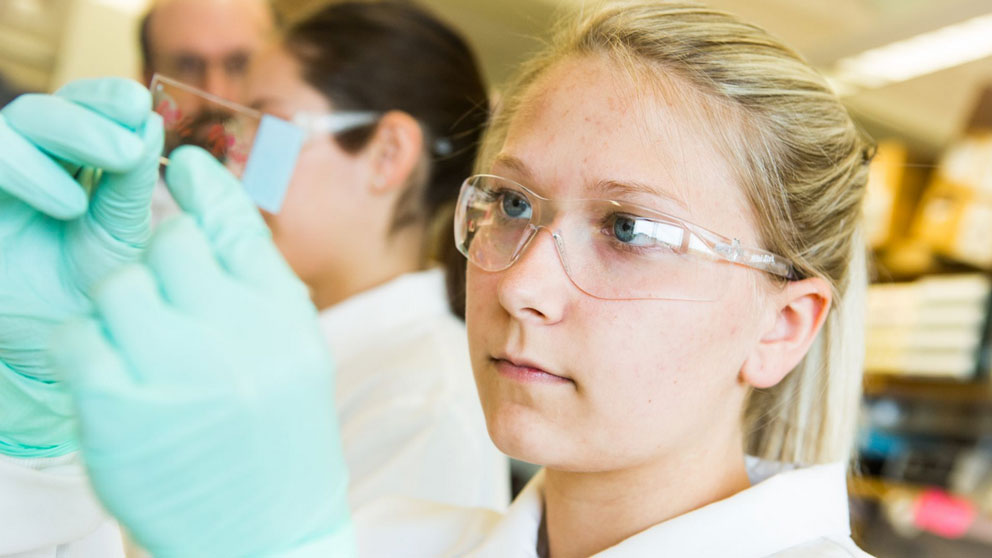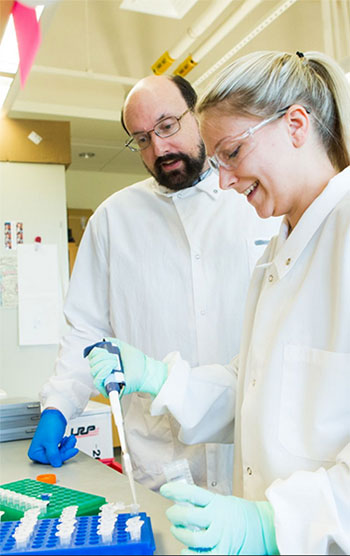 Photo by Tiffany Laufer
Photo by Tiffany Laufer
A college student explores the neuromuscular disease she lives with in a JAX research experience.
Like the other students earning a bachelor's degree in community health at the University of Maine, Farmington, freshman Cortney Lavorgna was required to find a two-week practicum, a work experience in a health-related setting.
But in Lavorgna’s case, the assignment is personal.
She’s spending two weeks at The Jackson Laboratory in Bar Harbor, Maine, in the laboratory of Associate Professor Greg Cox, Ph.D., an expert in degenerative muscular diseases including spinal muscular atrophy (SMA). Lavorgna has a mild form of SMA and is conducting hands-on research in the disease that sometimes hampers her mobility but never her goals.
Today Lavorgna is at the bench in the bustling Cox lab, graduate student Paige Martin by her side. They are preparing tissue samples for imaging, in order to analyze the degree of neurodegeneration in certain mouse models.
“I’ve learned so much already,” she says with a smile. “It’s almost too much to take in, but I want to learn as much as I can about this disease.”
Lavorgna first reached out to JAX more than a year ago, when she was researching the medical condition that had perplexed doctors for most of her young life.
“Back when I started walking, my mom noticed something was wrong with me — I walked on my toes,” she relates. Her childhood involved frequent out-of-state trips from her home in Maine for medical appointments, surgery and treatments. “It wasn’t until 2015 that a new neurologist made the diagnosis of SMA.”

Determined to learn more, she went online and discovered JAX and the work in SMA by Cox and Cat Lutz, Ph.D., director of the JAX Rare and Orphan Disease Center. Cox and Lutz invited her to visit JAX last summer and spent time with her describing what is now known about SMA and the latest research directions.
In SMA, different gene combinations can lead to widely varying categories of severity, from type 1, the leading genetic cause of infant deaths, through the adult-onset type 4, which has mild symptoms. Research using mouse models of SMA developed at JAX led to successful clinical trials, and finally FDA approval, of the drug nusinersen, which is now being used to treat the severest cases of SMA in newborns. Further clinical trials will be needed to establish whether nusinersen is also effective in patients like Lavorgna with milder types of the disease.
Though Lavorgna leads a normal life full of school, friends, family, fun, camping and boating, her condition hampers her activity level. “My whole life I haven’t been able to play sports or run,” she says. “I can’t walk for more than 5 minutes without extreme fatigue, so need to use a wheelchair sometimes. I would like to hike and do more things outdoors, but what I’m able to do is limited.”
Lavorgna receives regular physical therapy and is on the waiting list for a specific kind of therapy dog, a big Great Dane that can provide stability for her when walking and help her get back on her feet if she loses her balance.
Lavorgna meets with Cox each morning of her practicum at JAX. “He has been teaching me a lot about SMA,” she says, “things even my neurologist didn’t really explain in depth, as well as basic stuff I need to know to work in the lab.”
She says her nervousness about being around scientists has disappeared. “I thought it would be really intimidating to work in Dr. Cox’s lab, but he really acts like everyone is his colleague. And everyone that I've met here is super nice and welcoming.”
Martin, Lavorgna’s grad student mentor, comments, “It has been inspiring working with a student who has a neuromuscular disease, because it really reminds you why the work we do with our mouse models is so important — that there are human patients out there with real struggles that need to be addressed.”
Lavorgna’s eyes are already opening to new possibilities. “It’s been really great to have this opportunity to do hands-on research,” she says. “I think this experience will give me a better understanding of what I want my future to look like.
“Learning more about SMA is helping me to feel more in control, like the disease isn’t running my life. I now know I can do more to help myself and other people with SMA.”